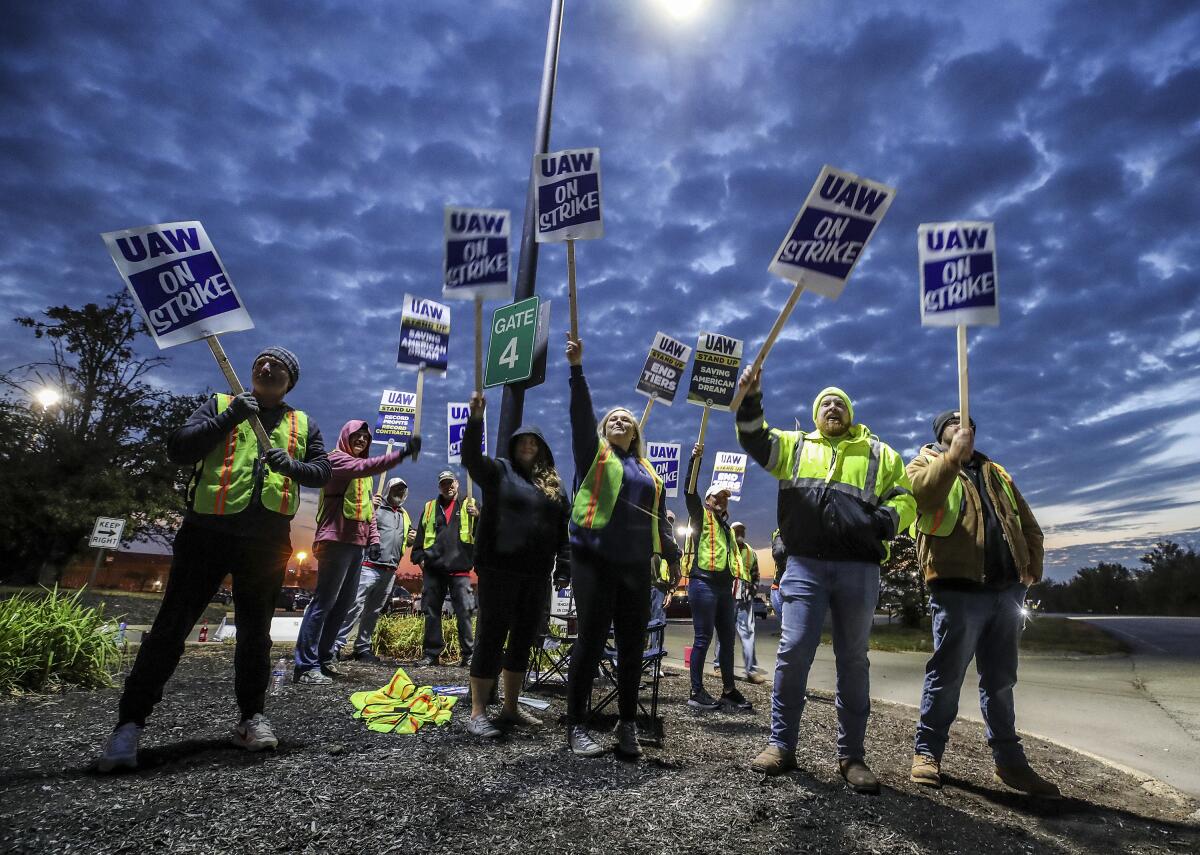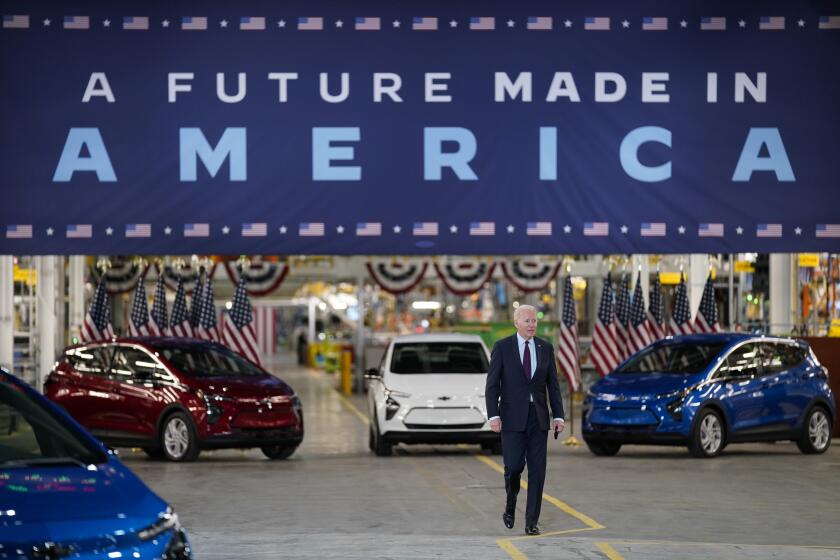Ford and UAW reach tentative deal to end autoworker strike

- Share via
The United Auto Workers reached a tentative labor agreement with Ford Motor Co., union leaders announced Wednesday night. The breakthrough puts pressure on the carmaker’s two chief rivals — which are set to meet with the union Thursday — to reach deals and end a protracted strike that has cost the industry billions of dollars.
“For months we’ve said that record profits mean record contracts, and UAW family, our stand-up strike has delivered,” UAW President Shawn Fain said in a video announcement. “What started at three plants at midnight on Sept. 15 has become a national movement.”
Fain did not announce details of the provisional deal, saying the union was aiming to make the information available to members by Sunday night. According to people familiar with the negotiations but weren’t authorized to speak publicly, the deal includes a 25% hourly wage hike and is subject to union leadership approval.
Once union leadership signs off, the agreement will need to be ratified by Ford’s 57,000 U.S. hourly workers, a process that could take weeks and has an uncertain outcome because expectations have been raised by Fain’s call for a transformational deal.
General Motors’ agreement to include autoworkers in battery manufacturing shows climate action to electrify the economy doesn’t have to mean abandoning workers.
Pay was one of the last issues to be worked out during the talks. The union had originally sought a 40% raise and 32-hour workweek before reining in its demands. Ford earlier agreed to cost-of-living allowances, converting temp hires and expediting how long it takes workers to get to the top wage rate.
The deal with Ford also includes a new battery plant in Michigan that the company paused construction on last month, one of the people said, without providing details. The status of future workers at these battery manufacturing sites has been a key point of contention in the talks.
General Motors and Stellantis are set to meet with the UAW on Thursday, and the union hopes they will agree to the same terms, according to people familiar with the negotiations.
The strike initially affected one vehicle-assembly plant at each of Detroit’s legacy automakers. It was the first time all three companies were targeted at once — a bet by Fain to keep them guessing about his next move. Within six weeks, the strike has grown to include more than 45,000 workers at eight assembly plants and 38 parts distribution facilities.
After the UAW launched a surprise walkout at Ford’s highly profitable Kentucky Truck Plant on Oct. 11, it announced that it was switching up its strategy to call strikes with little notice, which it said was a response to companies slow-walking talks before making any substantial offers.
Two more surprise strikes followed: at Stellantis’ Sterling Heights, Mich., plant that makes its bestselling Ram 1500 pickup truck on Oct. 23; and GM’s Arlington, Texas, facility assembling the Chevy Tahoe, GMC Yukon and Cadillac Escalade on Oct. 24.
In the video announcement, Fain credited the strikes at Sterling Heights and Arlington with increasing the pressure on Ford to the point that it was prepared to make a deal.
“We knew we were getting close, but we also knew the companies needed a major push if we were going to make sure we we got every penny in this agreement. So we took our strike to a new phase and hit the companies with maximum effect,” he said.
“Ford knew what was coming for them on Wednesday if we didn’t get a deal. That was checkmate.”
All three companies have said they don’t want to absorb labor costs that are so high that they would force price increases and make their vehicles more expensive than those made by nonunion companies such as Tesla and Toyota.
A study this month by Moody’s Investors Service found that annual labor costs could rise by $1.1 billion for Stellantis, $1.2 billion for GM and $1.4 billion for Ford in the fourth year of the contract. The study assumed a 20% increase in hourly labor costs.
GM on Tuesday said it already is preparing for added labor expenses, taking out $2 billion in fixed costs by the end of 2024. It’s also looking at other ways to save.
The company said that it lost $200 million in pretax earnings due to the strike in the third quarter and that it has lost an additional $600 million so far in the fourth quarter. After that, it could lose as much as $200 million a week, not including the Texas plant closure or any further walkouts.
The Associated Press was used in compiling this report.
More to Read
Inside the business of entertainment
The Wide Shot brings you news, analysis and insights on everything from streaming wars to production — and what it all means for the future.
You may occasionally receive promotional content from the Los Angeles Times.











